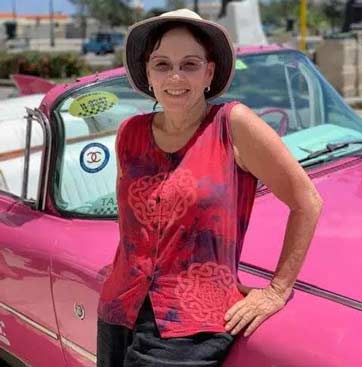Havana restaurants sometimes get a bad rap when it comes to variety and service. But the restaurant scene in Havana is in continuous evolution.
The fact is, you can now get some pretty interesting and innovative meals throughout the country.
From the far west valleys of Viñales to the eastern mountains of Santiago de Cuba, Cuban food and restaurants, especially Havana restaurants, have been experiencing a renaissance over the years.
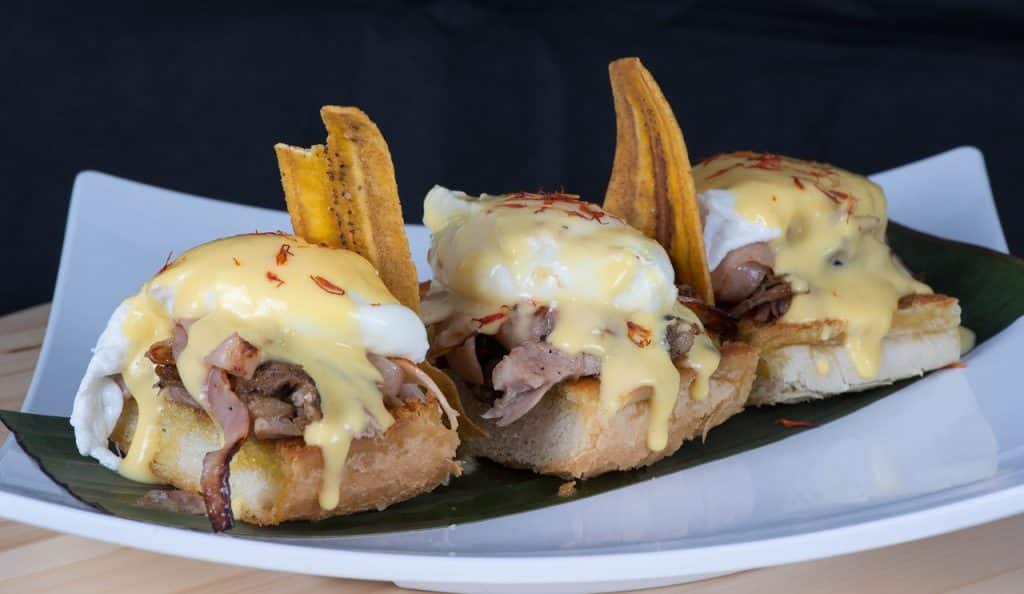
Table of Contents
ToggleHavana Restaurants: The Food and the Flavor
For some years now, private enterprise restaurants known as “paladares” have been flourishing in Cuba, but even more so in the capital city. Eating in paladares is one of the major DOs of the dos and don’ts for your Cuba trip.
Here is a little bit of history on how the paladares came about.
Shortly after the Berlin wall fell in the early 1990s, the Soviet Union, which had been propping up the Cuban government since the 1960s, cut off support to Cuba.
As a result, the country was plunged into a dire economic state which has come to be known as the periodo especial or special period.
The economic crises lingered and the average Cuban suffered. The government was forced to get creative to counter the effects of the economic crises.
One solution was to introduce a bit of private enterprise by allowing Cubans to set up a limited amount of tables in their homes and sell homecooked food.
These establishments were called paladares. The name means “palete.” The words paladar and restaurant are frequently used interchangeably.
The difference is that paladares are private enterprise restaurants rather than government run. Also, the paladares are better in almost every respect; quality, service, variety, ambiance.
The paladar concept took off and as they evolved, regulations changed. The more successful paladares left the confines of private homes and moved to more spacious and convenient accommodations.
Some paladares became so successful they found themselves competing on an international level with world-class eateries. One example is Doña Eutemia, a charming establishment just off Cathedral Plaza.
We hope these restaurants continue to weather the economic storms and pursue their dedication to delicious food in innovative environments.
Read on to learn about Cuban food and some unique Havana restaurants where you can sample authentic Cuban food in this fascinating city.
There are a couple of things that need to be established upfront. First, Cuban food is not spicy. Neither is it bland. These are common misconceptions that I am constantly surprised by.
Cuban food is very flavorful and, when done right, it is delicious.
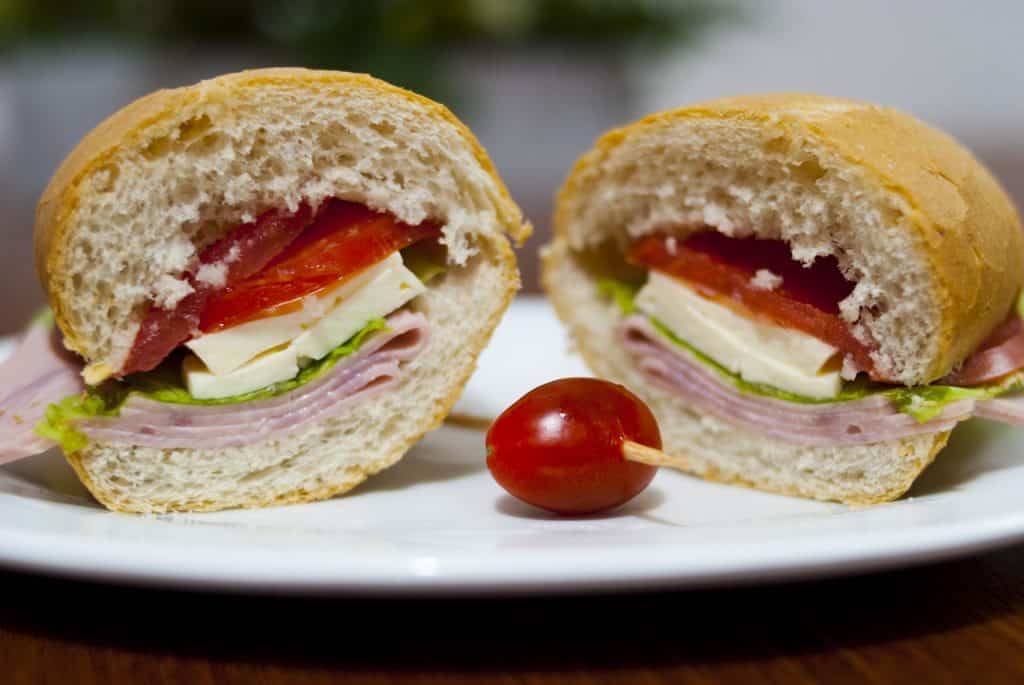
As is the case with many cuisines, the richness of contemporary Cuban food in Havana restaurants comes from the blending of many cultures throughout the centuries.
A Brief History of Cuban Food
The Spaniards arrived in Cuba in 1492 with their cooking methods and livestock. These blended with native Indian ingredients like corn, sweet potato, and guava.
A short while after, enslaved Africans were brought to Cuba from West Africa. They brought their own influences and introduced okra, plantain, and guinea hen.
By the early 19th Century, waves of French immigrants were flooding into Cuba retreating from the Haitian Revolution.
As if the influences of rich cultures like Spain, indigenous people, France and West Africa were not enough, 150,000 Chinese contract workers arrived in Cuba to work the sugar plantations around the mid-1800s.
Many of these workers stayed once their contracts were completed.
They too contributed cooking methods and ingredients to the local cuisine as they opened restaurants in what became the largest and most vibrant Chinatown in Latin America.
So now Cuba had influences from Europe, the Americas, Asia and Africa all blending, mixing, fusing and creating something unique and delivering the Cuban cuisine we know today.
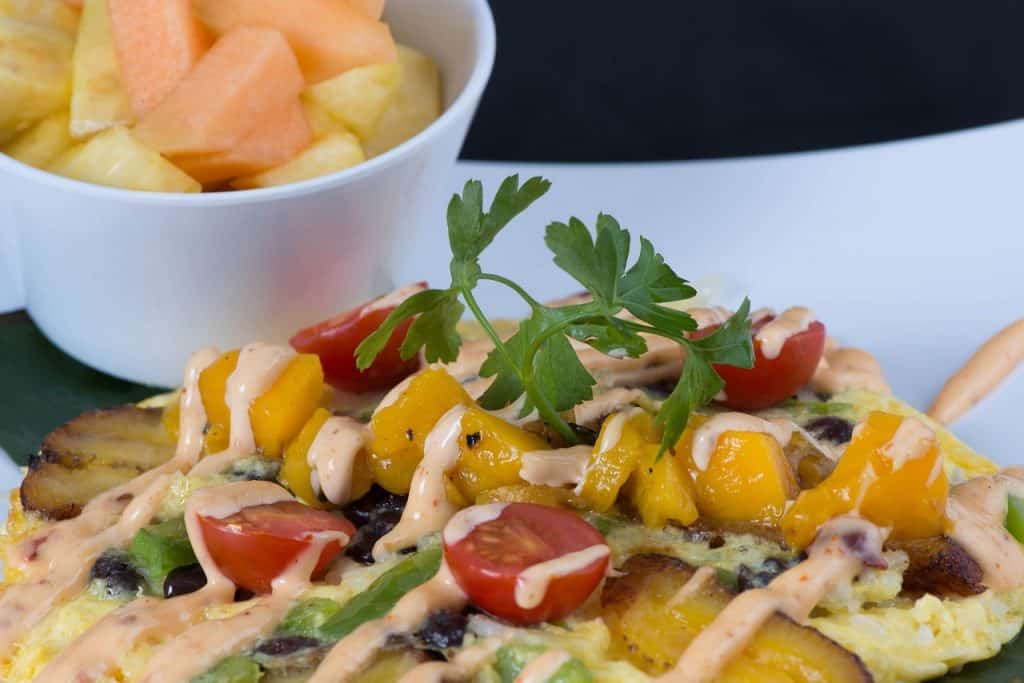
The foundation of a typical, contemporary Cuban dish is olive oil, parsley, garlic and onions. Most dishes spring from those ingredients.
The most popular Cuban dish is generally acknowledged to be “Ropa Vieja” which translates into “old clothes” so named due to its appearance of shredded cloth.
The dish is composed of shredded beef in tomato sauce seasoned with garlic, cumin and cilantro.
Another traditional dish is roast pork. This dish is eaten any time of year but especially during Christmas Eve “Noche Buena” celebrations.
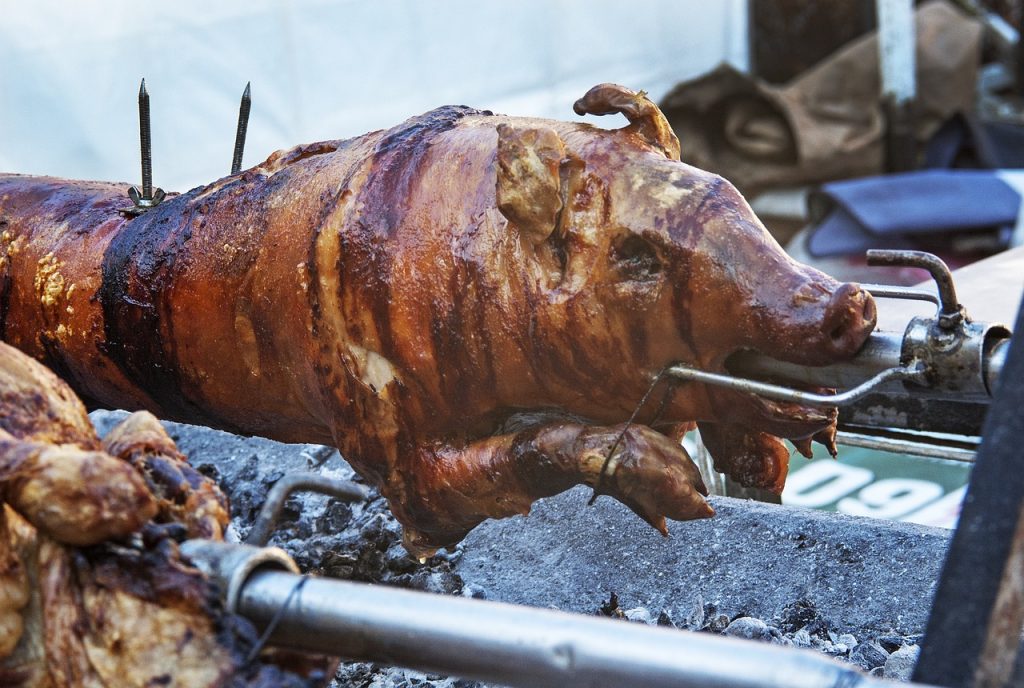
Common accompaniments or side dishes include white rice, black beans, fried plantains and yuca, a starchy tuber served with garlic and oil.
Havana has many restaurants offering a variety of international cuisine. However I wanted to focus on the eateries that offered typical Cuban food.
Herein is a curated list of the best places to have a classic Cuban meal in a Havana restaurant.
Five Notable Havana Restaurants
San Cristobal
On a side street in Centro Habana, this is where U.S. President Obama had lunch with his family when he traveled to Cuba.
As is the case with many paladares, San Cristobal was originally established in the owner’s home, a turn-of-the-century residence.
As the business grew so did the restaurant’s expansion until it filled most of the home. The decorations are eclectic and include a Santeria (local Afro-Cuban religion) altar.
In one corner sits a portrait of Obama. The wine glass he drank from is encased under a glass dome.
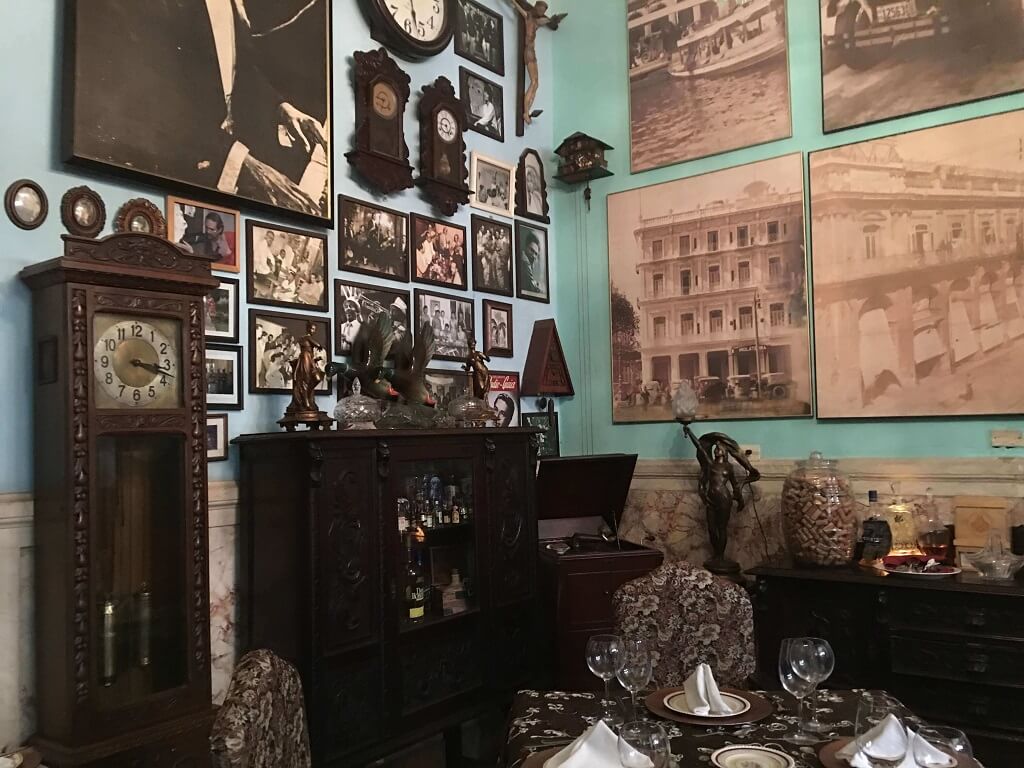
The food in Paladar San Cristobal can also tend towards the eclectic but solid Cuban fare is the standard. We had “chilindron de chivo” (goat stew). The best I’ve ever tasted.
*****
La Guarida
Everything about La Guarida is fascinating. Let’s start with its history.
The restaurant has been in the same location at Concordia # 418, in Centro Habana, for over 20 years.
What really put this restaurant on the map was that this is where Cuba’s most famous and awarded film, “Strawberries and Chocolate”, was filmed.
The building boasts graceful vestiges of better days and the entrance looks like it hasn’t seen a paintbrush in decades. That’s part of the charm.
You go inside, through an apartment complex where residents are hanging laundry, and up a rickety spiral staircase.
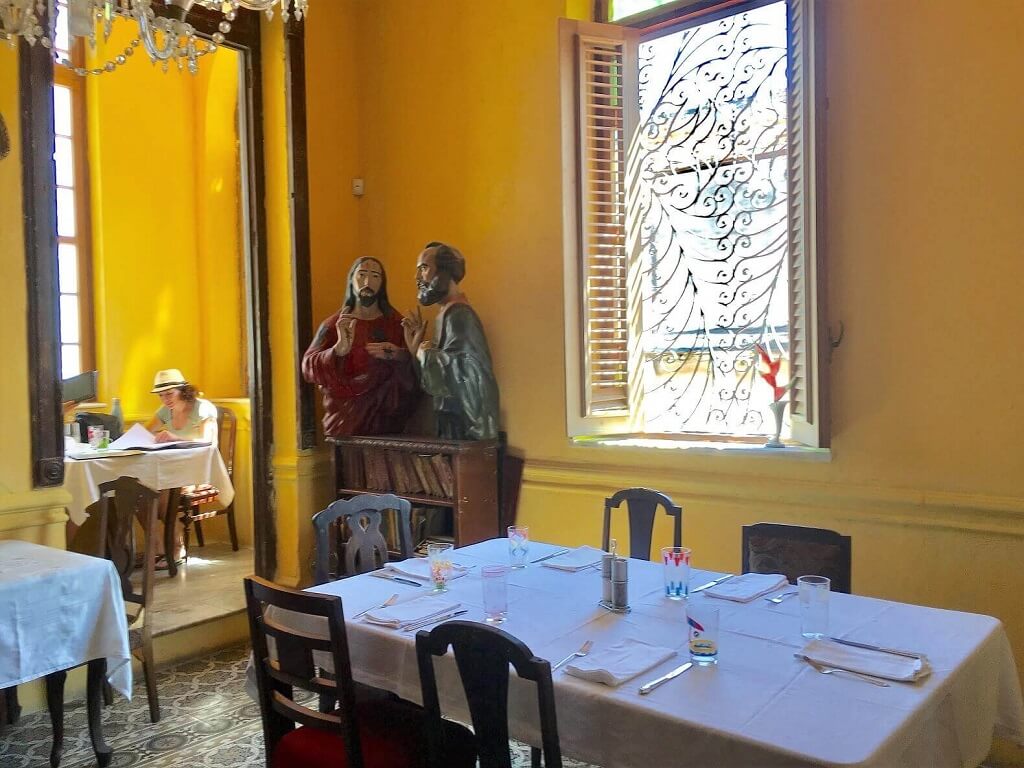
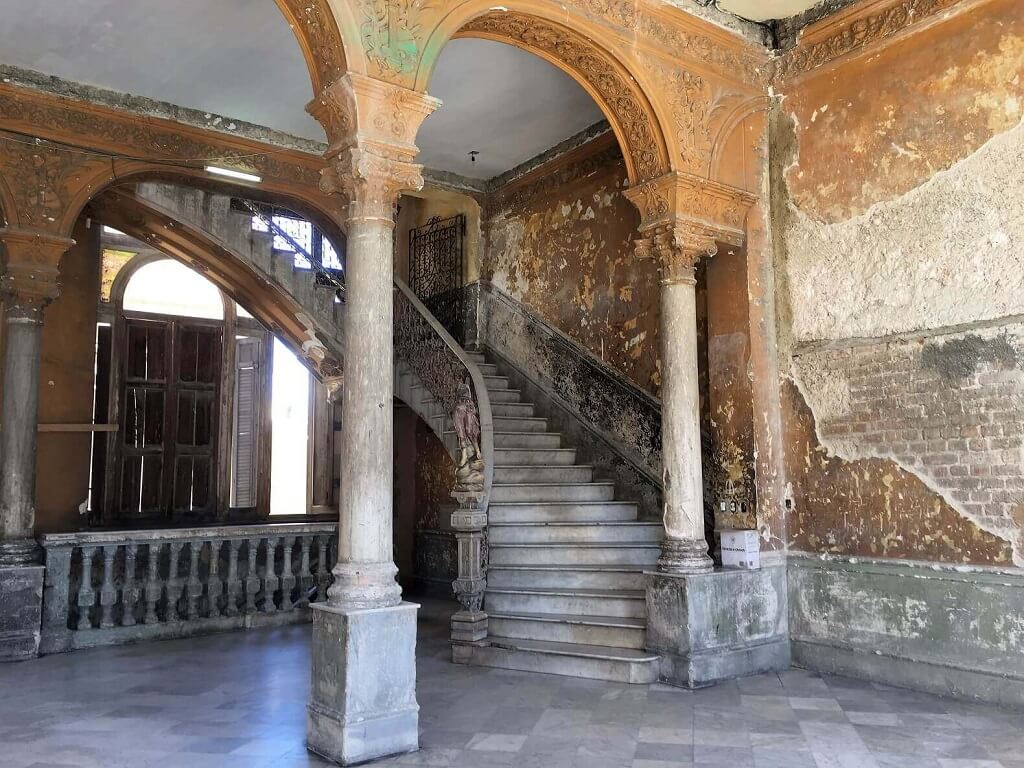
It’s on the landing where the whole scenario changes. The restaurant opens up to bright tropical colors of yellow and burnt orange.
Whimsical decorations cover the walls. The floors are wonderful examples of classic Cuban tiles from the turn of the last century. That’s the dining room.
Go up another flight of stairs and you’re on the rooftop with a cool breeze and expansive views. You can have a drink and snacks on the rooftop without having dinner. But do try to have a meal here.
The food is exceptional.
Some say it’s the best restaurant in Havana. It’s a little on the pricy side but worth it for the experience.
Insider tip: Reservations are highly recommended or you will not get a table.
*****
Doña Eutemia
In 2012, Doña Eutemia was voted one of the best 101 restaurants in the world by Newsweek.
This wonderful little paladar of Cuban culinary treasures sits right smack in the middle of Old Havana on a side street off Plaza de la Catedral (Cathedral Square) next to what is perhaps the most iconic sight in all Havana, the Cathedral.
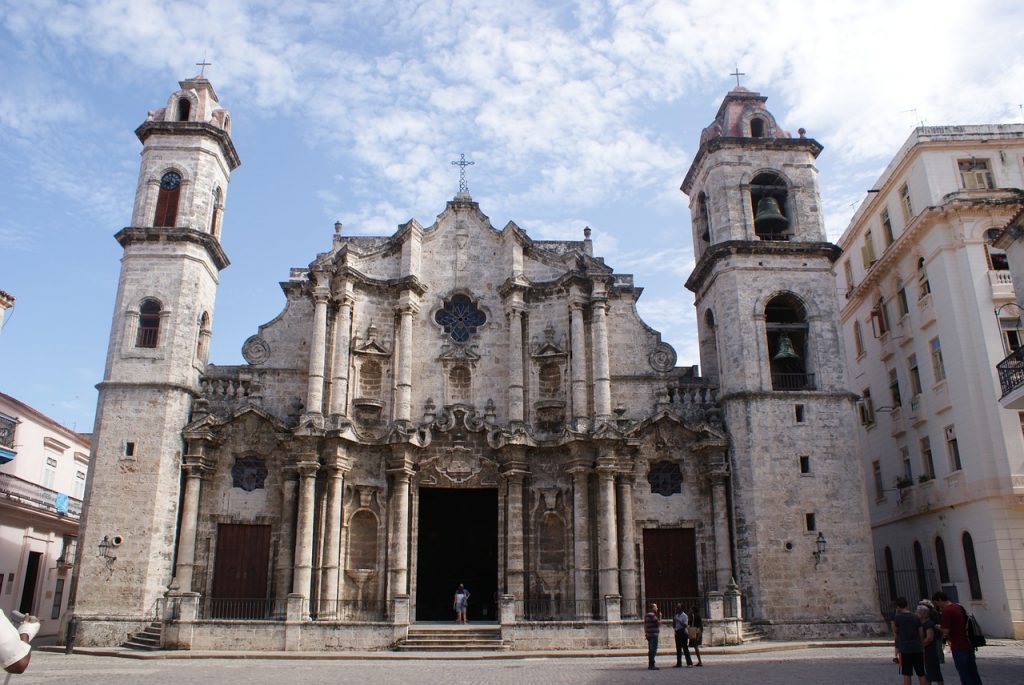
The restaurant was not accepting reservations last time I was there but this might have changed. The meals are reasonably priced and it is difficult to get a table.
We tried to get a table at 2 PM, an unusual time for lunch or dinner and were successful.
You may want to try a similar tactic. If you’re in Havana, do your best to try this place. You won’t be disappointed.
Insider tip: Try making a reservation at an unusual time to increase your chances of getting a table.
*****
El Cocinero
There is a lot to be said about El Cocinero. It is the only one of these five paladares that is outside of Old Havana or Centro Havana.
El Cocinero is located in the upscale neighborhood of El Vedado to the west of Havana. It is in a restored old cooking oil factory on the rooftop.
The food is classic Cuban at its core but it flares up to offer innovative creations around seafood and traditional dishes.
It is an explosion of flavors, colors and aromas in a unique and unforgettable venue.
The other resident of the restored cooking oil factory is the unique, Fabrica de Arte Cubano (Cuban Art Factory), or F.A.C. for short.
This is an entertainment venue unlike anything I have ever seen anywhere and a must-see in Havana.
Three or four massive floors of art exhibits, cinema, dance performances, musicians, dancing, restaurants, snack bars, poetry readings, fashion shows, bars…you name it, if it’s art, it is there.
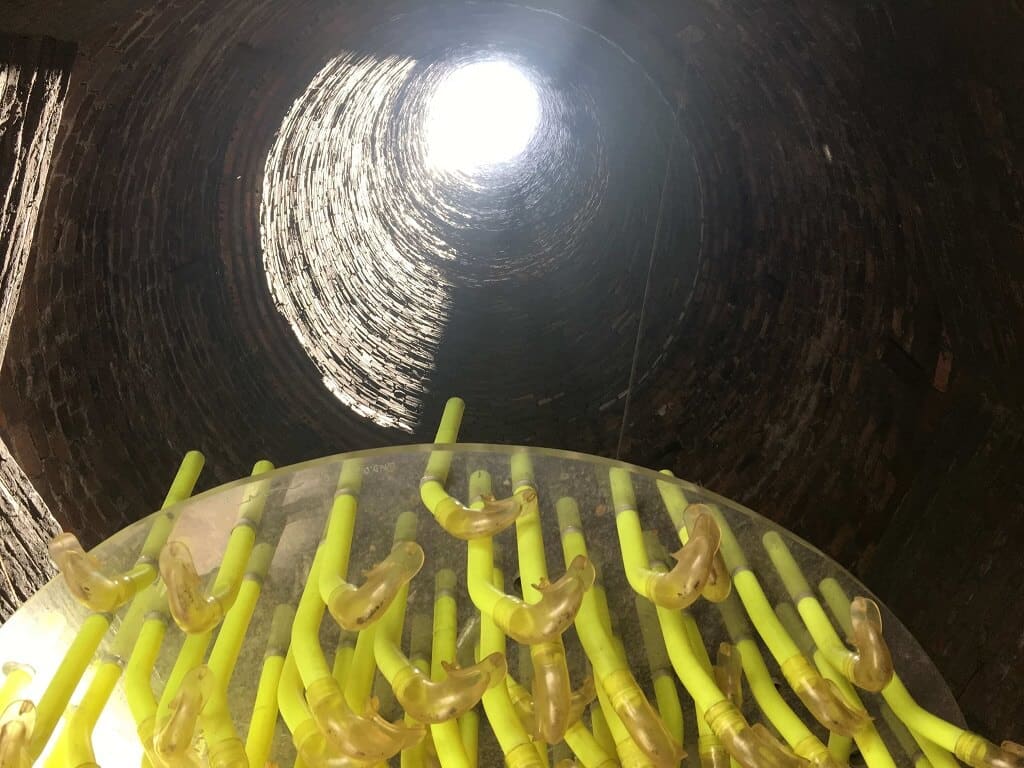
It makes sense to have dinner at El Cocinero and then head to the F.A.C. for an unforgettable evening. Doors open at 8 pm at the F.A.C. but the line to get in starts forming around 6:30.
Insider tip: Call for hours to both the F.A.C. and El Cocinero as they change frequently.
*****
Paladar Los Mercaderes
The paladar is named after the very busy thoroughfare it is on.
Los Mercaderes street runs north and south through Old Havana connecting two of Havana’s most picturesque plazas; Plaza Vieja and Plaza de La Catedral.
These are destinations you will find if you follow your own self-guided walk in Old Havana.
This is a wonderful street full of interesting stores, snack bars, parks and stunning architecture.
Los Mercaderes # 207, on the second floor in front of a leafy park with vendors selling everything from parrots to puppies.
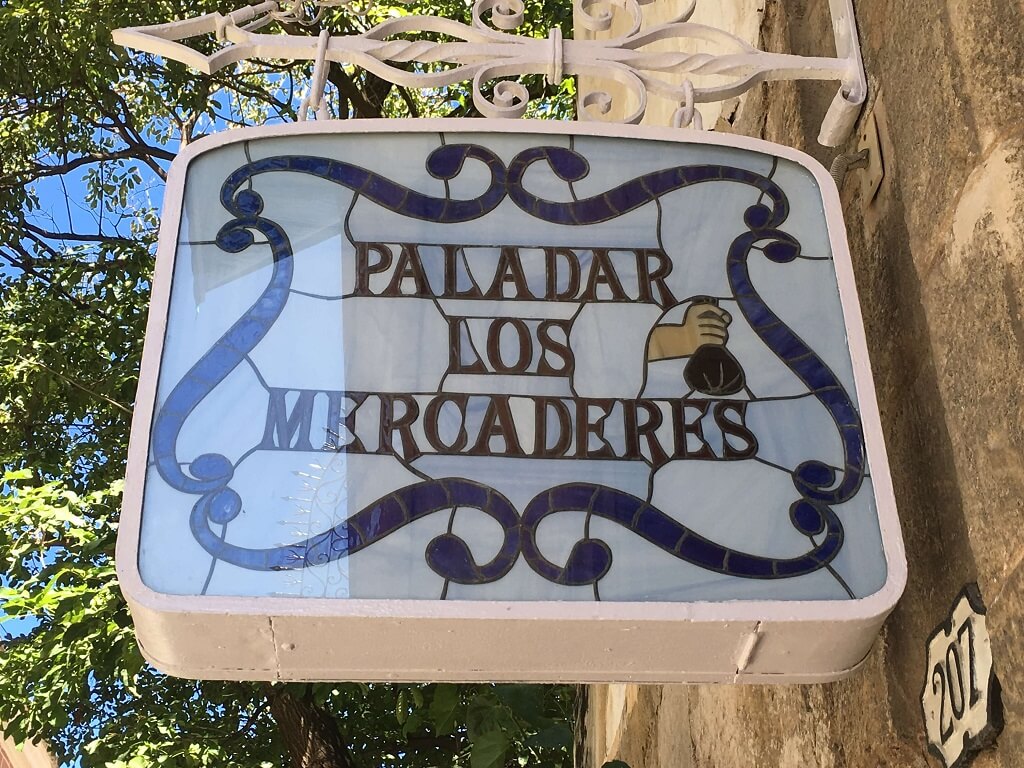
The paladar offers reasonably priced “menu del dia,” or daily specials at lunchtime. They frequently have musicians roaming the various dining rooms.
The food is classic Cuban with all the traditional trimmings. This place is hard to beat for ambiance, quality and price in the center of Old Havana.
We arranged for a surprise birthday celebration for one of our party, and it went off without a hitch! This is why Los Mercaderes is one of my favorite Havana Restaurants.
*****
New and Noteworthy
Le Petit Restaurant
This little gem is a recent addition to the best Havana restaurants and deserves honorable mention.
Nestled on the corner of Aguiar and Chacon streets in Old Havana (Havana Vieja), this restaurant is truly exceptional.
Despite its name, it has nothing to do with anything French. It is purely traditional Cuban with a nouveau Cuban flair.
In reviewing Le Petit, I personally found it an absolute delight. Reading the reviews on various sites, I did not find one single negative or even mediocre review.
How they managed that is beyond me.
Go to Le Petit for solid Cuban fare at reasonable prices, good service and conveniently located in Habana Vieja. What else could you ask for?
Plan H Wine Bar and Delicatessen
Don’t even think of leaving Havana without experiencing this delightful little gem.
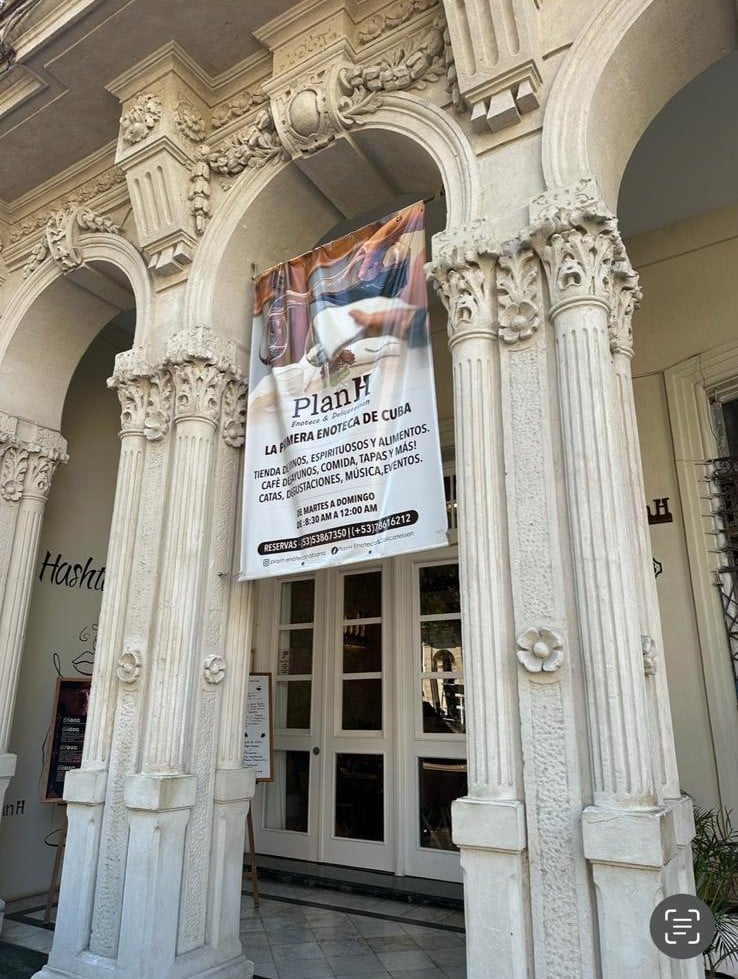
Plan H is a new wine bar that serves a wide selection of seriously good wines, light meals, tapas and snacks. All freshly made, beautifully presented, attentively served and YUMMY!
There are two other really cool features of this amazing place. First, it is owned and run by women and it promotes female entrepreneurship.
Second, it is right smack in the middle of one of Havana’s oldest, most beautiful and renowned avenues, the Paseo del Prado.
The restaurant also features music and events on selected evenings.
*****
Despite hardships and the scarcity of key ingredients in Cuba, Cuban chefs have continued to create. Cuban-American chefs Alain Rivas, Jaime de Rosa and James Beard Award winner, Douglas Rodriguez have led culinary tours to Cuba.
New paladares crop up with increasing frequency. Havana restaurants are coming into their own and attracting international attention. And prices have not reached those of similar restaurants elsewhere.
In no particular order, here are some of my other favorite restaurants in Havana by neighborhood.
Havana restaurants by neighborhood
Old Havana (Habana Vieja)
El Dandy is always fun. It has a pretty broad selection of fresh salads, sandwiches and small dishes.
These are served in what looks like someone’s living room with overstuffed chairs, mismatched lamps and large gilded mirrors.
They have a fun bar with tropical-themed specialties. My all-time favorite drink is a ginger-laced gin tonic. I have spent years trying to duplicate this drink to no avail (but it is fun to try).
The crowd is mostly tourists, but many Cubans stop here.
One of El Dandy’s attractions is that it sits on a corner of El Cristo Plaza, a major internet connection point.
Teniente Rey Street, El Cristo Plaza, La Habana
***
O’Reilly 304 and El del Frente
These two Havana restaurants are both on O’Reilly Street – numbers 304 and 303 respectively. O’Reilly is a busy thoroughfare running east to west in Old Havana.
The food is traditional Cuban fare, fresh, tasty and reasonably priced with similar – but not identical – menus in both locations.
The first restaurant was O’Reilly 304. It was so successful that they expanded across the street and created EL del Frente which literally means “the one across the street.”
El del Frente has a rooftop area for snacks and drinks which is also a lot of fun. You won’t go wrong in either of these two paladares.
#304 O’Reilly Street, La Habana
***
Mas Havana which means “More Havana” is a cool place with even cooler music.
Sometimes the musicians play during the week in the evenings, sometimes just on the weekends, so you’ll have to find out beforehand.
The food is standard Cuban but you go for the music which is world-class.
Habana Street No. 308 between San Juan de Dios and O’Reilly Streets, La Habana
***
El Café is more like an American cafeteria serving what you’d expect to find there, hamburgers, breakfasts, sandwiches and juices.
There is no Cuban food here, but it is solid tasty food in a centrally located, air-conditioned location.
#358 La Amargura Street, La Habana
***
D’Next is the closest you’re going to get to a Cuban sports bar.
They have satellite with many of the games so you can nurse a drink and snacks and cheer along with the locals.
The food is cafeteria-style and budget-friendly. Pizza is a specialty here. Many Cuban pizzas contain pineapple so if you don’t like that you can ask them to remove it.
They also have burgers and other small plates. Prices are reasonable with a burger costing about $5.00.
#512 Teniente Rey Street, La Habana
***
This is a high-end paladar that has been successful since it opened.
The name translates into “5 senses.” It is a formal Havana restaurant with attentive service and outstanding food.
Notwithstanding the venue, the prices are surprisingly reasonable with a main course going for less than US$20 per person. The wine was also well-priced.
I saw duck and rabbit on the menu which is unusual. We went with a group and everything was delicious.
This is a serene, pleasant place with everything you would expect of a fine dining establishment. I imagine this is what all high-end Cuban restaurants would have been like if politics had not interrupted their progress.
San Juan de Dios Street # 67, corner of Compostela Street, La Habana
***

The rumor is that Chef Ivan Justo was once a chef for Fidel Castro.
It wouldn’t surprise me at all. The food is good enough for any head of state.
This paladar is stretched out over two floors in an unassuming building that looks truly ancient. The restaurant specializes in seafood but there are also snacks and small plates.
The drinks are fun. One of the best mojitos I ever had in Cuba I had here at Ivan Justo.
My favorite part of this paladar, other than the food and the cool mojitos, is the ambiance with its interesting decorations and old photos on the wall.
Ivan Justo is centrally located in Old Havana and looks out on Prado Avenue with its beautiful walkway and fascinating architecture, one of the best walks in Havana.
Be aware that this paladar is frequently called by its address, Aguacate street # 9, rather than its official name.
Aguacate #9, corner Chacon, La Habana. Across the street from the Museo de la Revolucion (Museum of the Revolution).
***
This place is a little too touristy for my taste, but it is conveniently located, and the food is good. The menus are in English.
El Rum Rum is good for taking a break and grabbing a nice meal of comfort food; pizza, sandwiches and snacks, in an air-conditioned environment while you plan your next stop.
They also have more substantial fare like seafood at reasonable prices.
256 Empedrado Street, La Habana
***
This is hands-down one of the best paladares I’ve been to in Havana. The word “Chanchullero” translates loosely into “troublemaker.”
Chanchullero, is just off El Cristo Plaza that doubles as a major internet connection point. This paladar straddles two floors and it is always busy because it is always good.
I heard about how good it was and tried to visit a couple of times but the line out the door was always a deterrent.
Finally, I made it and ate at the downstairs section. I had pork, yuca (a starchy tuber drenched in garlic) and an avocado salad. It was exceptional.
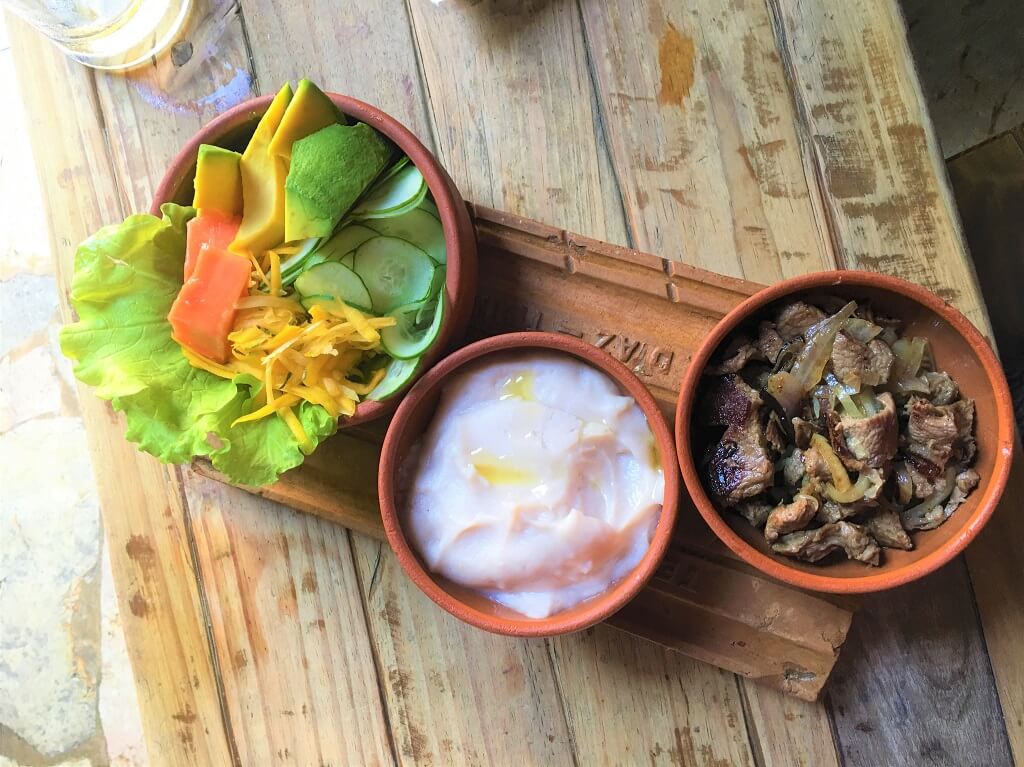
Tourists have discovered this place, yet it remains a bastion of solid traditional Cuban fare at its best.
Teniente Rey Street, corner Bernaza Street on El Cristo Plaza.
Note: The last time I was there in June 2022, it was closed. People nearby told me it would open shortly as they were closed during COVID. I hope so. I’d hate to lose this little gem.
***
Centro Habana
Centro Habana or Central Havana, is the neighborhood to the west of Old Havana. The dividing line between both neighborhoods is Prado Avenue where the iconic capitol building is located.
The neighborhood is quite different from Old Havana with much fewer tourists. This is an area where Cubans actually live and work vs just catering to tourists as in Old Havana.
The area can appear a little rough for first-timers, but it is very safe. The prices are noticeably lower than in Old Havana.
Centro Habana is home to two restaurants highlighted at the beginning of this post; La Guarida and San Cristobal.
Nurmi’s Cafe
This is a small unassuming paladar serving standard Cuban fare. The prices are very cheap and it caters mostly to Cubans.
It takes a while to get served because everything is made to order from scratch. Cuban home cooking at its best.
160 Neptuno, corner of Consulado Street, Centro Habana
***
This is another one of my all-time favorites.
El Biky is a couple of streets from the impressive University of Havana steps, on Infanta Street, a major thoroughfare.
El Biky is a restaurant, cafeteria, bakery and bar taking up the entire street and two floors.
The food is very good, the prices are reasonable -but not dirt cheap- and the service is attentive.
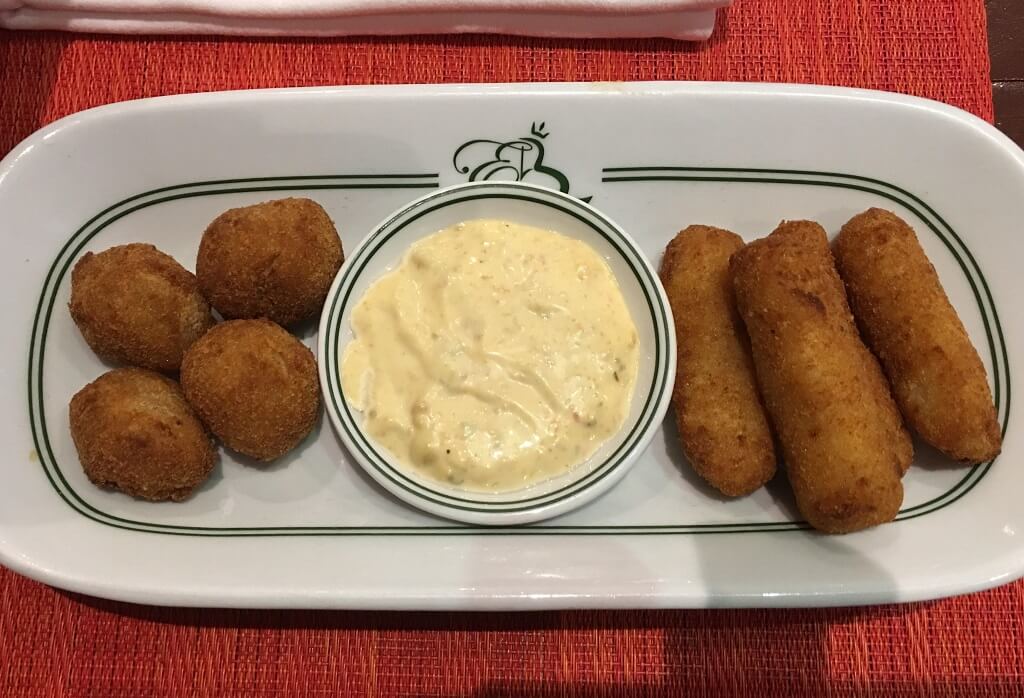
They have great American-style breakfasts with every fruit juice imaginable. It is also a good place to grab some sandwiches to take with you on a day-trip excursion or to the beach.
That food will probably be better than what you will get at your destination.
Infanta #412, corner San Lazaro and Concordia streets, Centro Habana.
El Vedado
El Vedado is the next neighborhood to the west of Centro Habana. The name Vedado means forbidden in Spanish.
During colonial times, the Spanish colonizers closed off the area, which had been a thick vast forest, and converted it to a military defense zone. Hence the name, Vedado.
Vedado is one of the neighborhoods where the upper-class pre-revolutionary Cubans lived before the 1959 revolution.
The neighborhood is full of crumbling mansions some of which have been turned into restaurants and casas particular (homestays or guest houses).
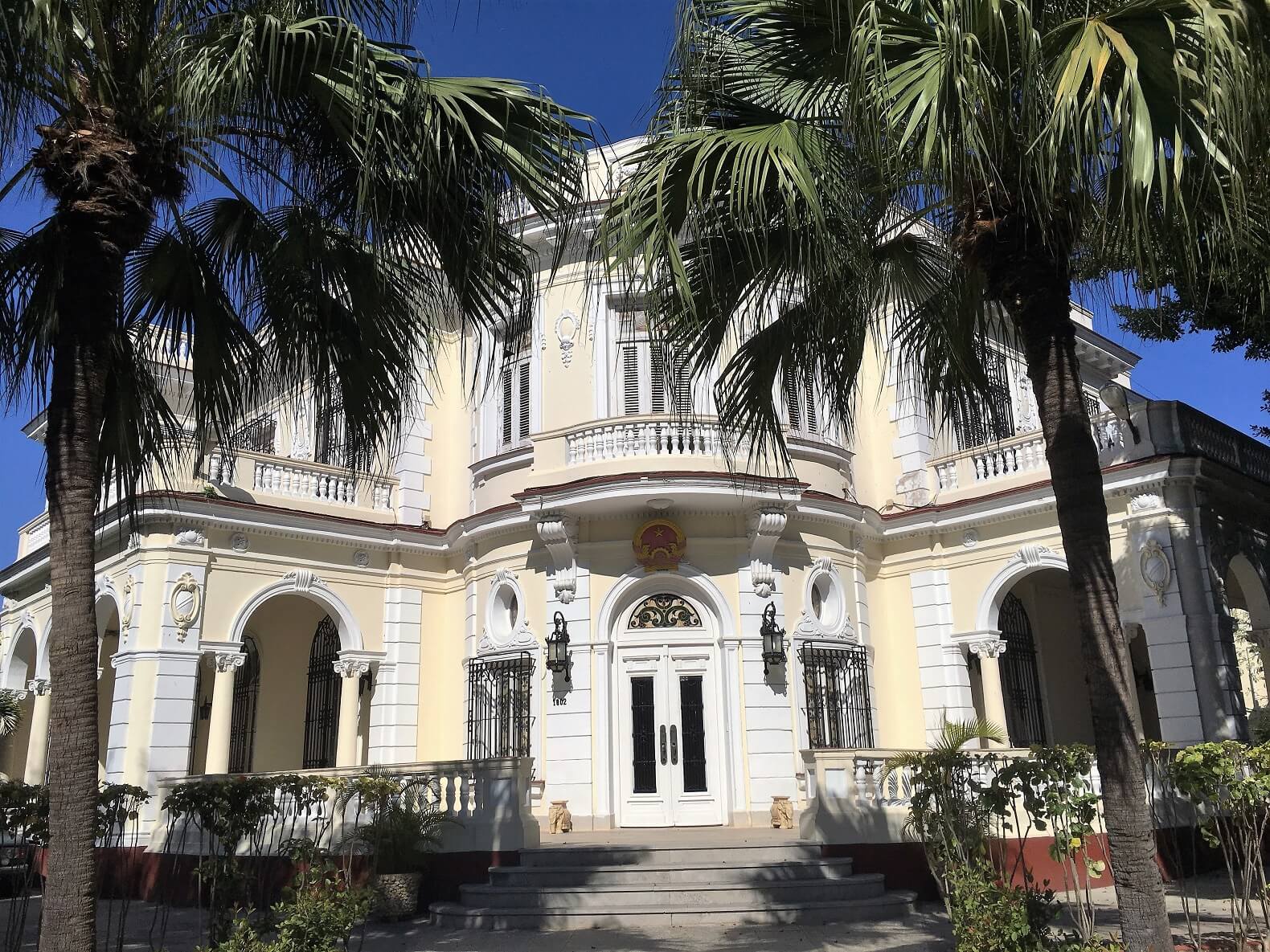
The main drag is 23rd Street, also called La Rampa. Some of the best restaurants in the area are found off this main street.
Vedado is home to La Fabrica de Arte Cubana (F.A.C.). This is one of the most innovative and unusual art venues anywhere. It is also where you’ll find El Cocinero restaurant mentioned above.
***
Another dining option close to the the F.A.C. – it’s actually in the next neighborhood over but close enough – is the seafood restaurant, Amigos del Mar (Friends of the Sea).
The food is fresh, reasonably priced and served in a pleasant environment with a water view.
O Street between 5th and 5TA-B, Miramar
***
This is a fun, unusual paladar smack in the center of Vedado near the Capri Hotel, a famous Mafia hangout of the 1950s.
The restaurant is in a high-rise apartment that must have been cutting-edge when first built.
You’ll have to really pay attention to find the front door because that’s all it is, a small unassuming little door.
Inside, an antique elevator takes you to the fourth floor where you’ll find the restaurant with spectacular views of the city.
The walls are covered in 1950s newspapers and advertisements and the whole place has a pre-revolutionary vibe.
The food is very good, classic Cuban with some international dishes.
What’s most interesting about the place is that it is in a converted apartment, as are many other restaurants in Havana.
***
Just like it is fun visiting Havana paladares in unusual venues like a high-rise apartment or a refurbished factory, El Atelier is fun to visit because it is in one of those beautiful old pre-revolutionary mansions.
You should visit one of these renovated mansions to imagine what life was like for the pre-revolutionary, ultra-wealthy barons of industry and commerce.
The food is excellent – among the best of the Havana restaurants – and worth every bit of the price tag.
You’ll get no Cuban bargains here although prices are still reasonable by international standards.
Take a moment to walk around the restaurant and check out the art which is for sale. It is very difficult to get a reservation so keep trying and book at a less popular time.
Try to get a seat on the terrace and dine by the twinkling lights.
5th corner of Paseo and 2, Vedado
Where NOT to Eat
Hotels in Cuba are government-owned or joint ventures with foreign entities.
The food in hotels tends to be bland and at international prices. Don’t bother with these.
Head to the paladares, support private enterprise and chalk up another “support for the Cuban People” activity.
There are a couple of touristy places that you should visit but are not good choices for meals. The first is El Floridita, one of Ernest Hemingway’s haunts.
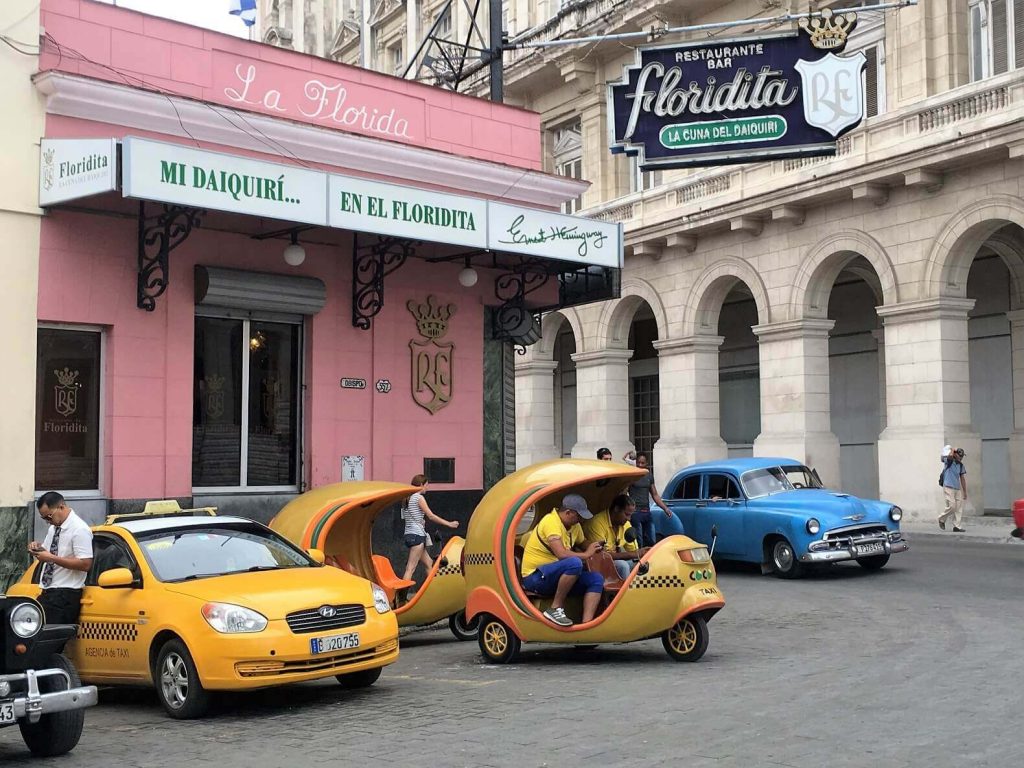
The rumor is the daiquiri, one of the four classic Cuban cocktails, was invented here. It wasn’t. It was invented in the town of Daiquiri in western Cuba.
The food here is bland and exists solely to separate tourists from their money. Still, do visit and take a photo with the life-size bronze statue of Hemingway at the bar.
Granted this is a very touristy thing to do and may not be your thing, but I’m a sucker for these silly touristy activities and you may be too.
The other Havana restaurant not to eat at is La Bodeguita del Medio, another Hemingway haunt.
Here the writer sipped mojitos and wrote his name on the wall like hundreds of other visitors -you can too.
Definitely visit but don’t eat here. The food is indifferent at best. There are many more interesting and delicious restaurants in Havana.
Havana Street Food
Most of the street food mentioned here costs less than one U.S. dollar unless otherwise stated.
Fried plantains accompany many Cuban dishes.
These tasty, thick, and flattened pieces of plantain are eaten as a very common side dish, like potatoes or rice and are sold on many street corners from street vendors.
Another plantain variation is the very thin deep-fried plantain chip which is eaten like a potato chip.
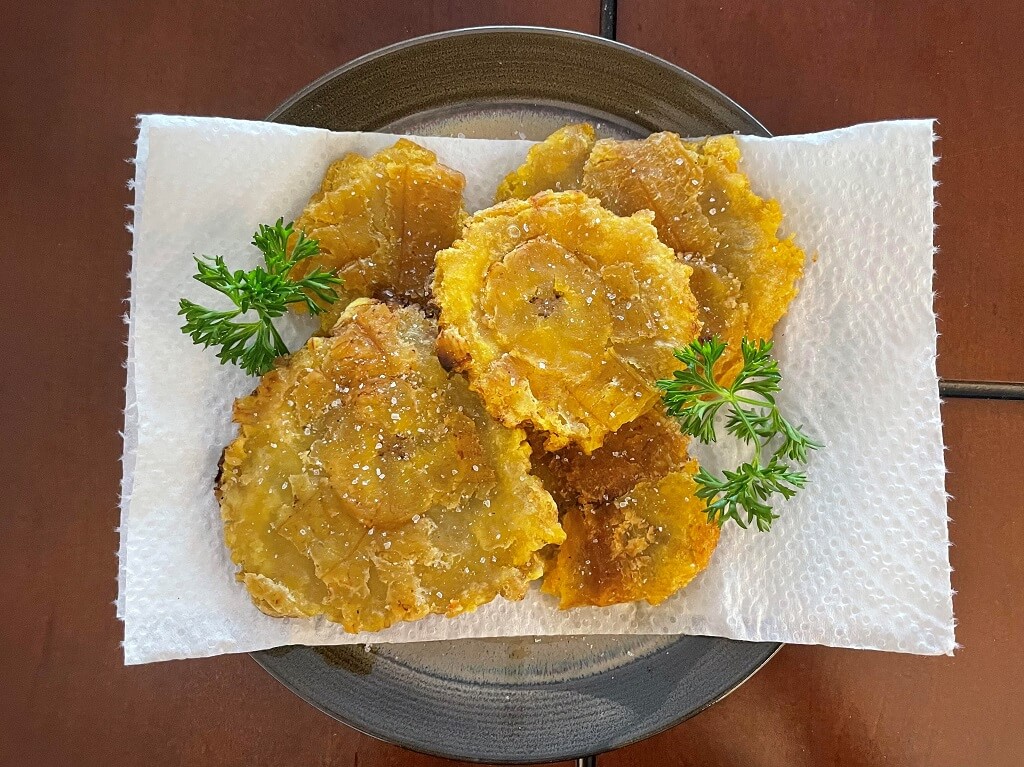
Coconut ice cream made with fresh coconuts and served in real coconut shells is a real treat on hot Havana days.
It is sold in many tourist areas mostly from restaurant windows where there is access to refrigeration.
Pizza is ubiquitous in Cuba. You are never too far from a slice no matter where you are.
Heads up: Cubans love to put pineapple pieces on pizza. Fair warning.
Malanga fritters are pieces of taro, a tuber-like root, dipped in an egg and garlic mixture and then deep-fried to a golden brown.
They are frequently served with a dip in restaurants but on the street, you’ll get them wrapped in the local newspaper.
Other common street food includes various sandwiches, mostly egg or sliced pork. These sandwiches may cost more than one U.S. dollar, maybe US$1.50.
Churros, originally from Spain, are sugar-coated deep-fried dough sticks. Curiously addictive.
Coppelia Ice Cream is an ice cream shop on 23rd Street in the Vedado neighborhood. Here you can get scoops of yummy ice cream for cents. The line is long but worth it.
Cangrejitos, which translates into “little crabs” are fruit-stuffed pastries in the shape of a twisted design resembling a crab, hence the name.
There is a tiny shop – fits only two customers max – across from the capitol building that sells them. You can’t miss it, just look for the line.
Insider tip: Cangrejitos are also sold in other parts of the city but that little shop seems to be ground zero.
Fruit pastries. Similar to cangrejitos above, these fruit pastries are flaky and filled with different fruits. You’ll see vendors with their carts wandering the streets.
Look for the little groups of people congregating around them. Buy a bunch and take them with you to the beach.
Cucurruchos de mani. These are peanuts, frequently warm, served in a cone-shaped paper container called a cucurrucho.
This is me at 6 years old in the Havana Zoo holding a cucurruccho full of peanuts.
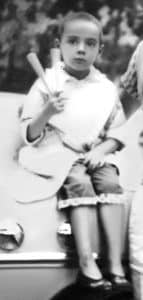
And now for the queen of street food not only in Cuba but, arguably, anywhere in the world. Drumroll, please…the BATIDO. Practice saying it…”ba-ti-do.”
Phonetically it is pronounced “bah-tee-doe.” The word means “shake” as in milkshake or fruit shake. You will want to know this word.
Cuba is blessed with a wide assortment of delicious local tropical fruits: mango, guava, pineapple, soursop, papaya, tamarind, bananas, coconut, and passion fruit…and that’s barely scratching the surface.
They have fruits you’ve never heard of.
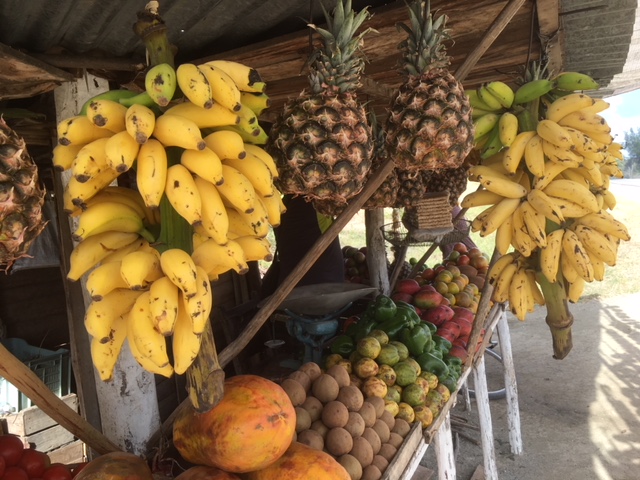
These tropical fruits are used to make shakes or juices and are among the most delicious concoctions you will ever encounter on a street corner or a storefront anywhere on planet Earth.
Seriously, this stuff is so good you will stop total strangers on the street, shove these shakes in front of them and say, “Taste this, taste this!”
Definitely one of the Cuban treats you should try.
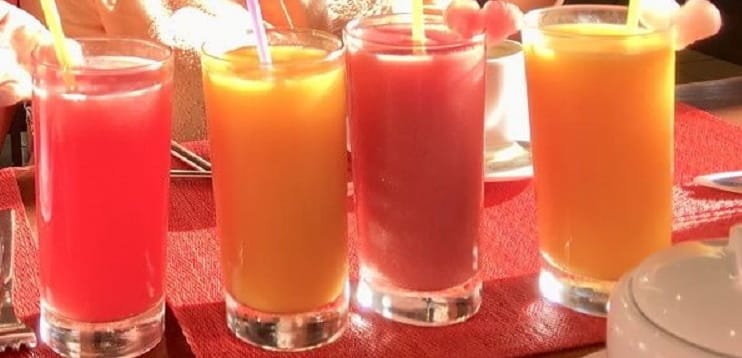
Havana restaurants will surprise and delight you with their quality and tasty, innovative cuisine.
Have you had Cuban food? Where? Share your stories.
Do you know where you will be staying in Havana? I recommend you stay at a “casa particular” this is a Cuban B&B.
These are reasonably priced, serve killer breakfasts and can be found throughout the country.
You can book a casa particular online on many guest house websites like Homestay.
And make sure to bring my book over with you, Don’t Just Travel to Cuba, Experience It: The Ultimate Cuba Travel Guide.
Want to learn how to make Cuban food at home? Try recipes from these Cuban cookbooks:
What are your thoughts about Havana restaurants? What Cuban food would you like to try? Let us know in the comments.
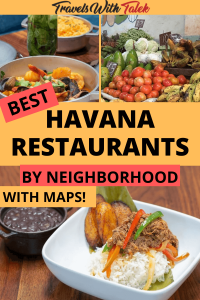

BTW, if you are getting ready for your trip, make sure to take advantage of these useful, money-saving links to book your trip:
- Research and book your flight with Skyscanner. I have found them to be the best because they list all airlines including the budget ones. You are always sure of having researched all options.
- For car rental around the world, Discover Cars has flexible pickup and drop-off options, I recommend Discover Cars.
- Book your accommodation with Booking.com. I find they have a wide selection and a nice, user-friendly, transparent website.
- Protect your trip and, more importantly, protect yourself with travel insurance. I use Travelinsurance.com and have been very happy with them.
- Looking for a small group tour to unforgettable destinations with top professionals? Intrepid Travel is your choice.
- For more general tours to any destination or attraction, book with Viator. Check them out.
- Need a visa? Get your visa for all countries with Passport Visa Express.
- Looking for a cool walking tour to explore a city? My favorite walking tours are offered by Take Walks.
- Food and drink tours are the best way to enjoy a city. And Devour Tours are my favorite.
- Looking for a good VPN to protect your security, privacy and freedom online while traveling? Nordvpn is your best option.
- The best and most economical way to stay connected while traveling is with an Airalo eSIM.
I personally use, and can recommend, all the companies listed here and elsewhere on my blog. By booking through these sites, the small commission we earn – at no cost to you – helps us maintain this site so we can continue to offer our readers valuable travel tips and advice.






